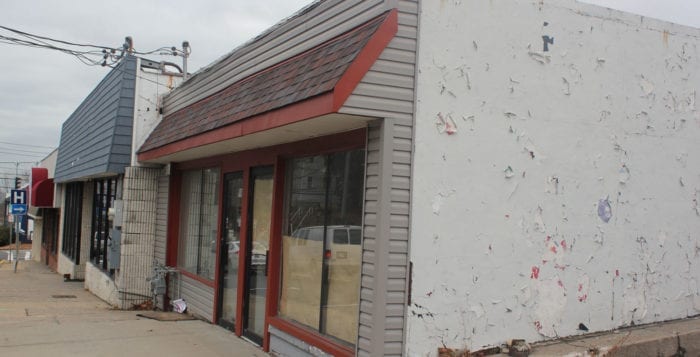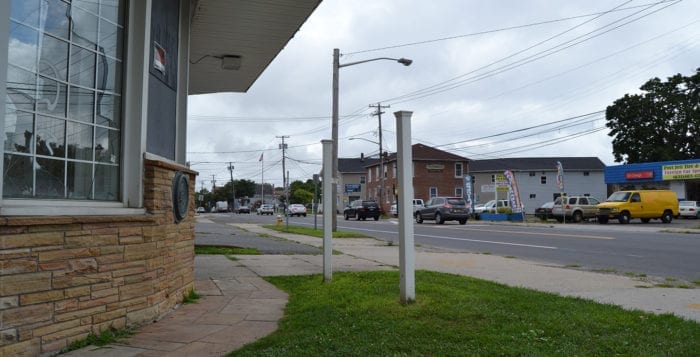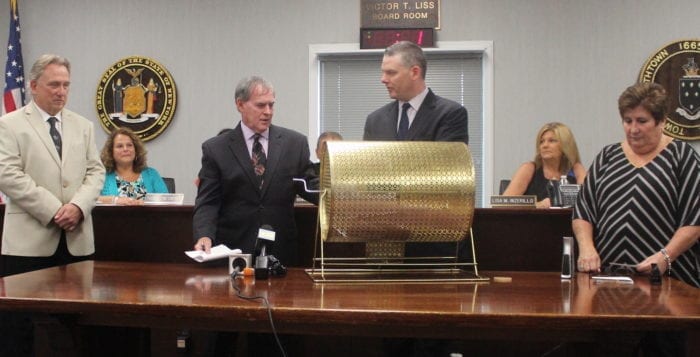More than 600 people gathered together loudly chanting, “Enough is enough,” and calling for measures to help bring an end to gun violence in schools at a Huntington Station park this past weekend.
Members of Students against Gun Violence LI, a student-led coalition calling for stricter gun control measures, were joined by parents, Huntington area residents and community members in a rally July 29 at Breezy Park. This event aimed to build on the momentum gathered in the March 24 marches in response to the February Parkland, Florida, school shooting, encouraging young adults to voice their opinions on gun control issues at the polls this November.
“America just loves its guns more than its people and if that’s not f****d up, I don’t know what is,” said Lucy
Peters tearfully, as the niece of Dix Hills native Scott Beigel, who was killed in the Parkland shooting. “We need to elect ‘orange’ politicians who see gun control for what it is — a human issue and not a political issue.”
We need to elect ‘orange’ politicians who see gun control for what it is — a human issue and not a political issue.”
– Lucy Peters
Orange has been adopted as the color worn and displayed by those protesting stalled gun control measures.
Peters stood alongside relatives of other Parkland shooting victims: Commack resident Paul Guttenberg whose niece, Jaime, a student, was killed, and Linda Beigel Schulman, mother of Scott Beigel, in calling for stricter gun control measures.
“On Feb. 14, 2018, a 19-year-old was not mature or trustworthy enough to handle a beer but was mature and trustworthy enough to handle a weapon of war, an AR-15 assault rifle,” Beigel Schulman said, in questioning gun control laws. “In what world does that make sense?”
The mother of the 35-year-old Parkland shooting victim called out Long Island politicians who have offered their “thoughts and prayers” to victims of mass shootings but have not voted in support of gun control legislation, specifically naming U.S. Reps. Lee Zeldin (R-Shirley) and Peter King (R-Seaford). Beige Schulman said in the wake of Scott’s death, she had chosen to make gun control reform her life’s mission and encourages others to take action.
“People ask me, ‘What can we do to support you?’ My answer is so simple: Make sure you get out and vote.”
– Linda Beigel Schulman
“People ask me, ‘What can we do to support you?’” she said. “My answer is so simple: Make sure you get out and vote. Then make sure to tell at least two more people to get out and vote.”
U.S. Rep. Tom Suozzi (D-Glen Cove), who co-sponsored the Huntington rally, stressed the importance of high school and college students continuing to voice their opinions on national issues by registering to vote and holding politicians accountable for their viewpoints in the upcoming
midterm elections.
“We need young people to continue to keep a youth movement going in this country to focus on this issue of gun violence,” Suozzi said. “This is a unique time in history. The adults have failed and we need young people to keep this going.”
Huntington resident Owen Toomey, who has been actively involved in March for Our Lives Long Island, stressed that the movement has defined five major legislative goals that it is fighting for. First on that list is universal background checks for gun purchasers.
“I accept that my innocence has been eroded by the fear of gun violence, but I refuse to accept that same fate for upcoming generations.”
– Gia Yetikyel
Other goals of the movement include upgrading and digitalizing the federal Bureau of Alcohol, Tobacco, Firearms and Explosives registry; a ban on the sale of high-capacity gun magazines and semi-automatic assault rifles, and getting Congress to approve funding for the Centers for Disease Control and Prevention to research and study gun violence.
“When people ask what you are rallying for, tell them our goals,” Toomey said. “Remind them we aren’t banning guns, remind them we aren’t taking their guns, remind them we aren’t taking away their sport or self-defense — we are just making it harder for someone to kill 15 people in the span of six minutes.”
Gia Yetikyel, of New Hyde Park, recalled how terrified she was 17 years old and her high school experienced an incident that required a lockdown. While crouching in the corner of the classroom, she reported sending out text messages to her mother to ask about a younger brother’s safety, sending messages to beloved family and friends all while making a list of goals she had yet to accomplish.
“I’ll be telling them the young on Long Island have never rested or stopped fighting for what is right.”
– Avalon Fenster
“I accept that my innocence has been eroded by the fear of gun violence, but I refuse to accept that same fate for upcoming generations,” she said.
Yetikyel said she still suffers effects from that day and, as such, fights for stricter gun control measures.
“We send out condolences to the families of the dead, but I’m still sending them to the living for having to fight this battle that shouldn’t even exist,” she said.
March for Our Lives Long Island co-founder Avalon Fenster, of Dix Hills, announced that she will be taking her pledge to fight for gun control legislation to the national level. She’s been invited to join the “Road to Change” national March for Our Lives Tour as a representative for Long Island alongside Parkland survivors Emma González and David Hogg. The tour stopped in Greensboro, North Carolina, from July 31 to Aug. 2 to rally for gun control while showing active opposition to the National Rifle Association.
“I’ll be telling them the young on Long Island have never rested or stopped fighting for what is right,” Fenster promised those gathered. “We will resist. We will register, and we will bring justice.”
































